Bulgari
Automatic Chronographs of the 21st Century
Bulgari
Automatic Chronographs of the 21st Century
Bvlgari’s BVL 318 Chronograph GMT
Unique quality: Automatic, ultra-thin, horizontal clutch chronograph
Chronograph construction is frequently defined in two design types: classical and modern. The modern construction has two versions: a cam-and-lever actuated chronograph, or the vertically coupled chronograph, where the axis of the chronograph runner shaft engages with the gear train. Classic chronographs are horizontally coupled, where the chronograph runner wheel meshes directly with the gear train. Because of the meshing and when the teeth don’t fit perfectly due to their positions, it causes the flicker or “bounce” that the chronograph seconds hand experiences at the start of its operation. The numerous benefits of vertically coupled chronographs mean that we rarely see a classic chronograph today, and certainly nearly never with an automatic function.
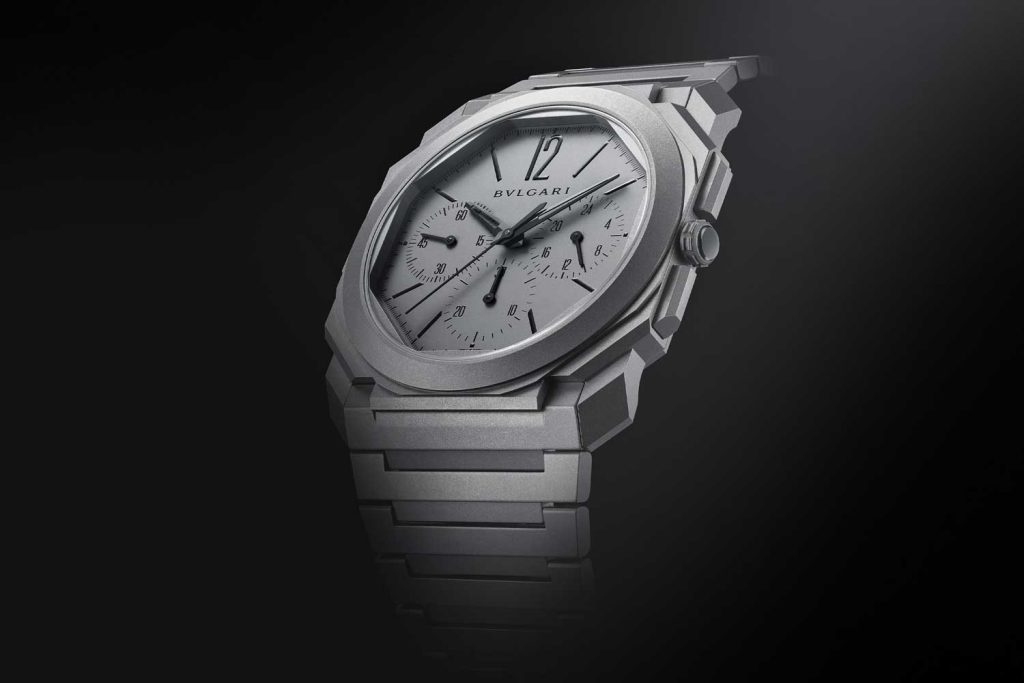
Bulgari Octo Finissimo Automatic Chronograph GMT , 2019
TAG Heuer Calibre Heuer 02 and Heuer 02T
Unique quality: COSC-certified chronograph with tourbillon
TAG Heuer is probably one of the most prolific chronograph makers in the Swiss watch industry and over the course of its history, it has developed numerous innovations in chronograph design. Along with Breitling, it was one of the participants in the development of the Calibre 11, while also launching the first water-resistant, square case watch in 1969. In 1887, it developed the oscillating pinion, which was an alternative to the classic column wheel in controlling the operations of the movement. The benefit of the pinion was that it could be manufactured industrially rather than constructed by hand, allowing for greater numbers of movements to be produced.
Over the last decade, it has developed a number of chronograph movements and the Heuer 02 calibre is based off the CH80 which was released in 2014. The Heuer 02 appeared in the Autavia chronograph re-issue, a watch that was designed by Jack Heuer himself. It was a particularly notable timepiece as the decision to re-create this timepiece was made via public voting from a range of 16 Autavia timepieces at the 50th anniversary of the Autavia’s creation.
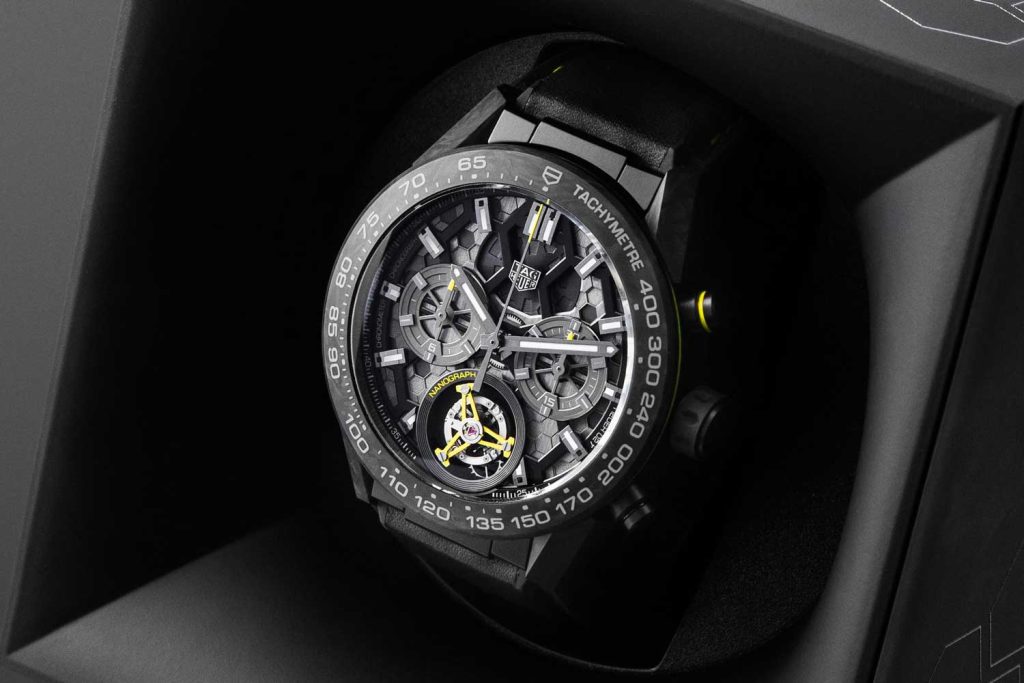
TAG Heuer Nanograph
The movement features a column wheel and vertical clutch, and a tourbillon model was added to the Heuer 02, that’s the Heuer 02T. The tourbillon movement was COSC-certified and also earned itself the Tête de Vipère from the Besançon Observatory, one of the highest standards in precision timekeeping. But the most interesting development with the Heuer 02T came this year in Geneva, when the brand presented a special edition, the Nanograph, featuring a brand new carbon composite hairspring and aluminum alloy balance wheel. The escapement offers optimum isochronism across temperature ranges and makes the movement one of the most outstanding in value, design and performance. Where innovation is concerned, this is one of the most important chronographs of our era.
Patek Philippe Calibre 28-520
Unique quality: Patek Philippe Seal
For a long period in Patek Philippe’s watchmaking history, the brand relied on a famed chronograph, the Lemania 2310, for its automatic and manually-wound chronos. In 2009, it developed the CH 29-535 manually-wound chronograph and the following year, the automatic CH 28-520 was released. The vertical clutch, column wheel chronograph is an impressive design and one that has a Spiromax hairspring and Gyromax balance wheel with four gold collets. The use of silicon, one that Patek was in early research together with Rolex, the Swatch Group and Ulysse Nardin, offers numerous benefits, from a lubrication-free operation to amagnetic properties, reduced energy loss in the system (leading to greater power reserves) and consistent performance across a broad range of temperatures and climates.
The CH 28-520 is also highly precise, bearing the Patek Philippe Seal, which has a higher standard of accuracy than COSC. The Seal’s standards for timekeeping state that movements which are above 20mm in diameter must have an accuracy of -3/+2 seconds a day, with tourbillon movements at a higher standard of -2/+1 seconds day. What sets the standard further apart from other certification formats is that Patek Philippe tests its movements as they are assembled in the watch case, not on its own. Along with the accuracy tests, there are also quality tests for the decorative techniques used on the movement, such as anglage and perlage, among other criteria. Suffice it to say that Patek Philippe holds themselves to a higher standard than the hoi polloi.
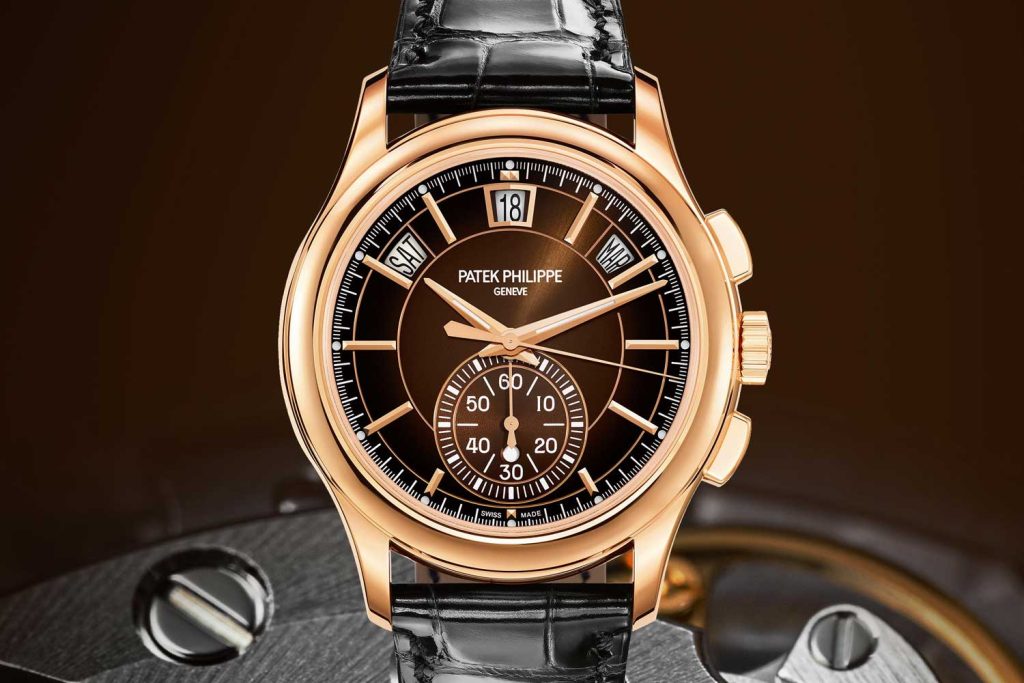
Patek Philippe Chronograph Annual Calendar 5905R
Zenith El Primero 9004 and 9020
Unique quality: Ultra-high speed chronograph
Since the LVMH Group’s Watch and Jewellery division established its research division, it’s been divvying up technologies among the group’s watch brands. With Zenith, it’s fixed on developing some of the finest high-speed chronographs on the market. The El Primero movement, turning 50 this year, has gotten a significant amount of juice since 2017 leading up to this year. The powerful 9004 calibre has two escapements, one for the chronograph and another for timekeeping, while retaining all the qualities of the integrated chronograph movement. The chronograph runs as a brisk 1/100th of a second, making a full round on the dial each second and with a chronograph power reserve display at 12 o’clock.
You’ll recall that the high-speed chronograph construction has its origins in TAG Heuer. However, the 9004 calibre’s construction is notably different from that of TAG Heuer’s, with a multi-layer construction in the movement. In fact, it’s upped its game this year with the 9020 calibre, which brings both escapements to the front of the watch, and houses each escapement in a tourbillon cage. The time-keeping tourbillon completes a rotation each minute, and the chronograph tourbillon once every five seconds. It’s gone further to demonstrate the performance of the watch, certifying the movement with the COSC.
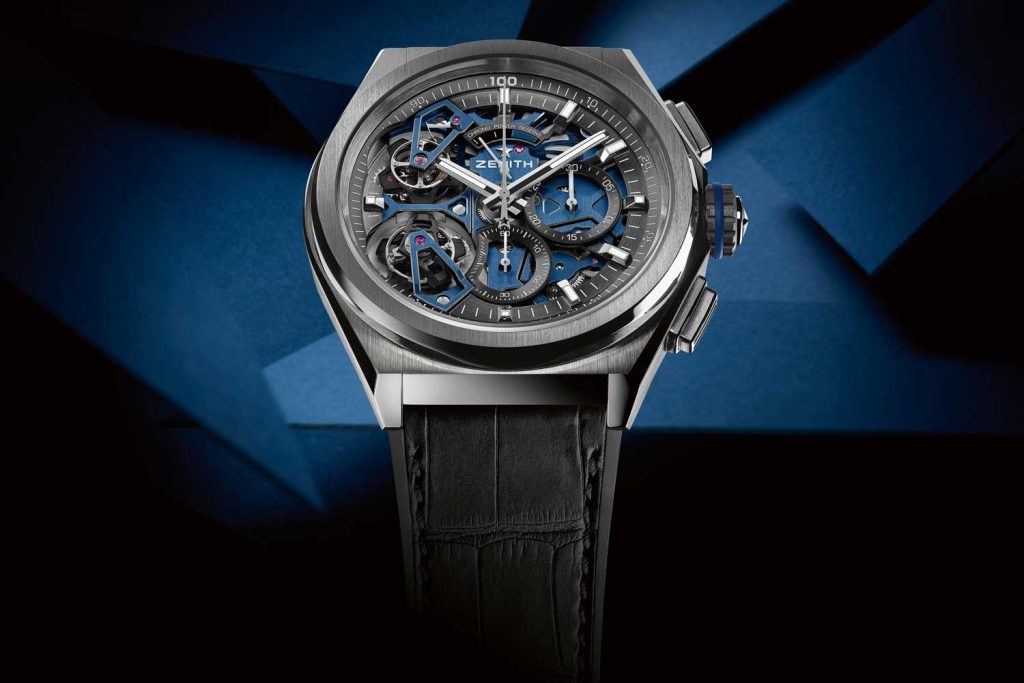
Zenith Defy El Primero Double Tourbillon
The Omega Master Co-Axial Chronograph 9900
Unique quality: Co-Axial escapement
Sometime in the 1980s, the late Nicolas Hayek, former chairman of the Swatch Group, took notice of a new escapement design by an English watchmaker named George Daniels and became interested in incorporating it into their movements for Omega. In fact, Daniels, during his development of the Co-Axial escapement, had hand-produced the components to retrofit his own Omega Speedmaster Mark 4.5 with his own Co-Axial escapement. Omega hired Daniels to help industrialise the design and released the first version of a Co-Axial movement in the calibre 2500 on a De Ville watch. Since then, Omega’s Co-Axial has become the brand’s signature.
Co-Axial escapements have a great number of benefits, from reducing sliding friction in a classic Swiss lever escapement to minimising impact corrosion, improving the lifespan of the movement and reducing maintenance needs. In 2007, the brand improved the design of its Co-Axial calibres to make more space for the escapement, enhance energy flow and added a silicon hairspring to defend the watch movement against magnetism. At the Baselworld in 2015, the brand presented a new certification standard developed with the Swiss metrology institute, METAS. Omega’s expanded the number of calibres that bear the Master Chronometer certification since, which includes the 9900 chronograph.
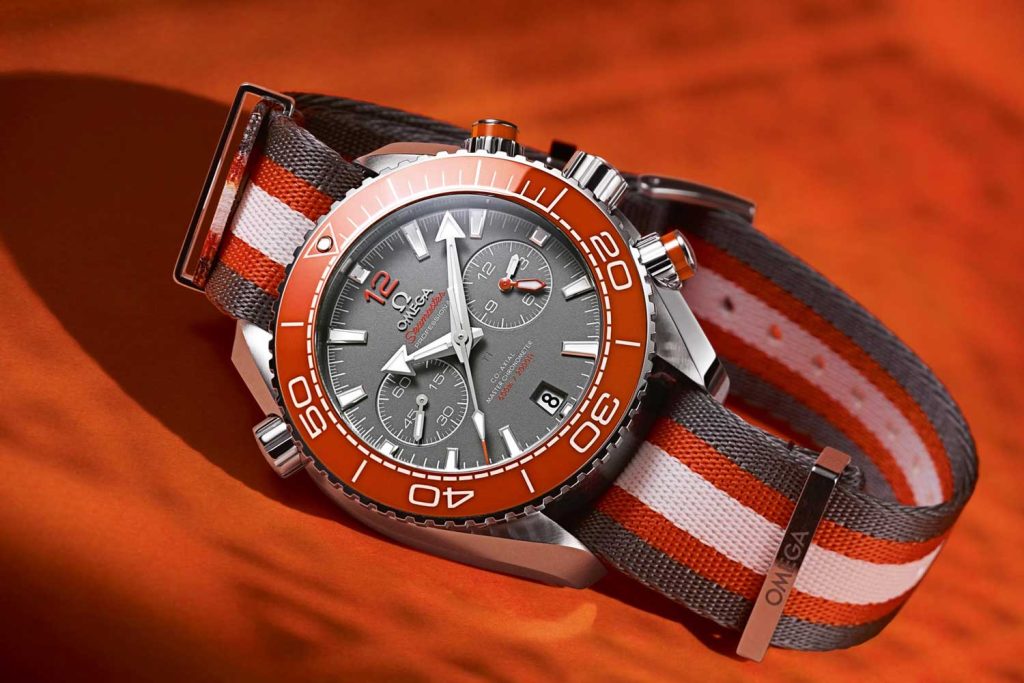
Omega Seamaster Planet Ocean
Grand Seiko Calibre 9R96
Unique quality: Spring Drive
In 1968, Seiko released the first Hi-Beat movement, a 5Hz calibre 61GS which won the mechanical chronometer wristwatch category in the Geneva Observatory Competition that year. A decade later, the Spring Drive system came along, which is a hybrid system with a rotating rotor that’s speed managed by an integrated circuit system with an electromagnetic brake, through a comparison with a crystal oscillator. The result is a highly accurate movement, with a longer power reserve. Spring Drives average a rate difference of +/-15 seconds a month, and higher quality movements such as the 9R96 series, are +/- 10 seconds a month. The Spring Drive Chronograph movement features a column wheel and vertically coupled chronograph, and Seiko is the only watchmaker producing a high-end, integrated chronograph that uses a hybrid quartz-and-mechanical construction to deliver precise timekeeping.
The 9R96’s improved accuracy comes from the choice of the more accurate and temperature-constant quartz oscillators that regulate the rotor’s rate, and it was introduced this year to celebrate the 20th anniversary of the first Spring Drive. It’s used in the Sport chronograph series, and its superiority among its Spring Drive peers is indicated in the use of the Golden Lion emblem on the oscillating rotor.
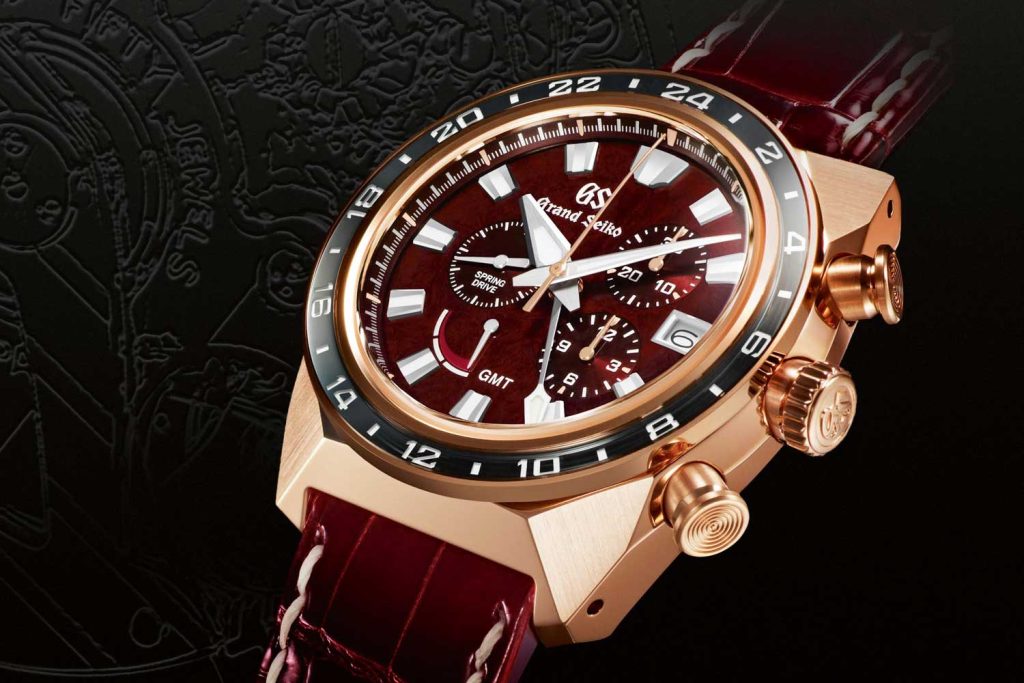
Grand Seiko SBGC230










